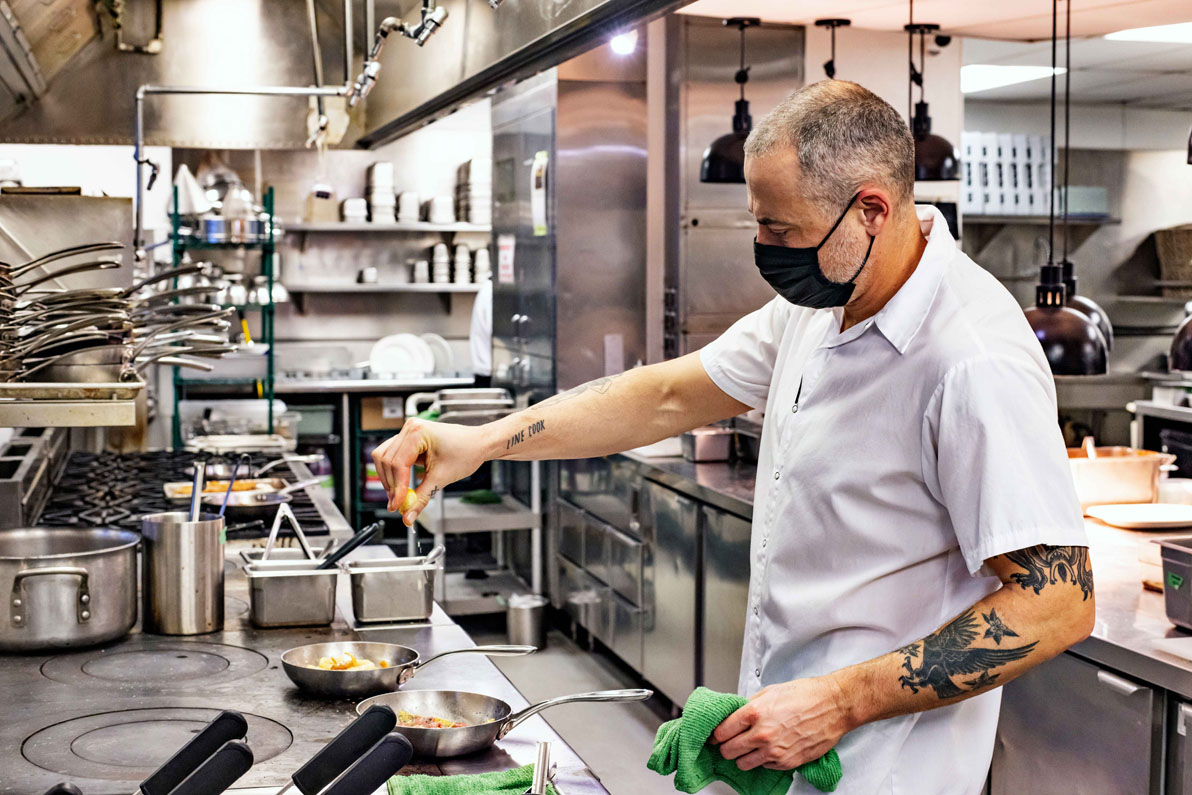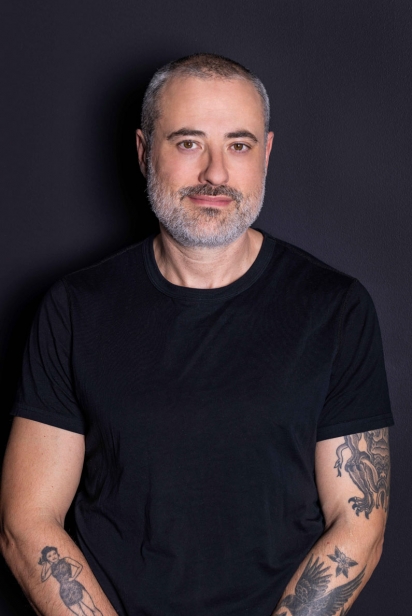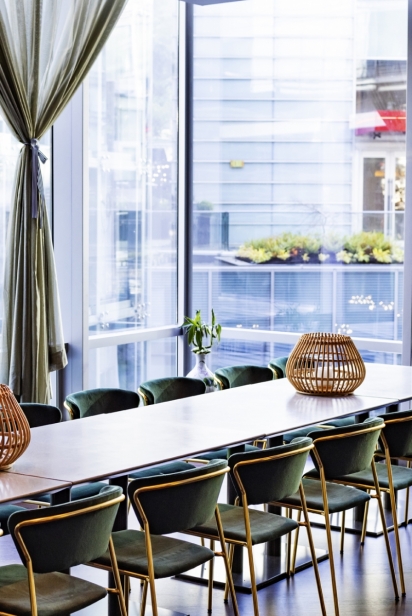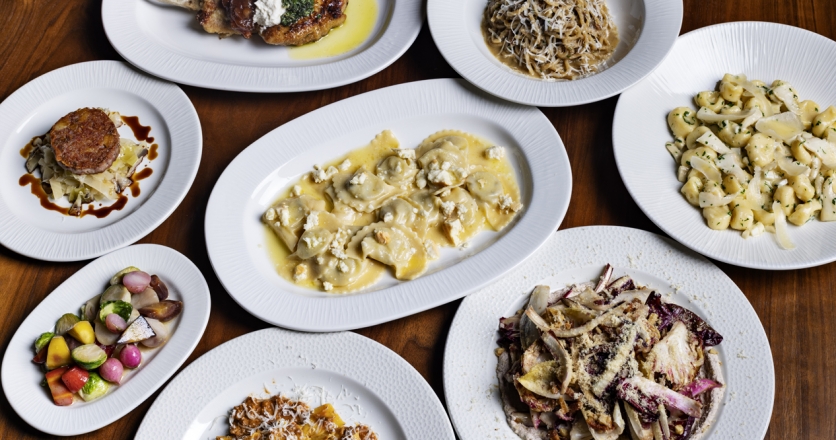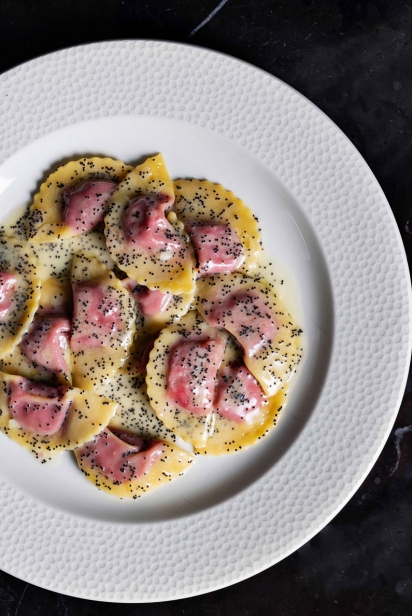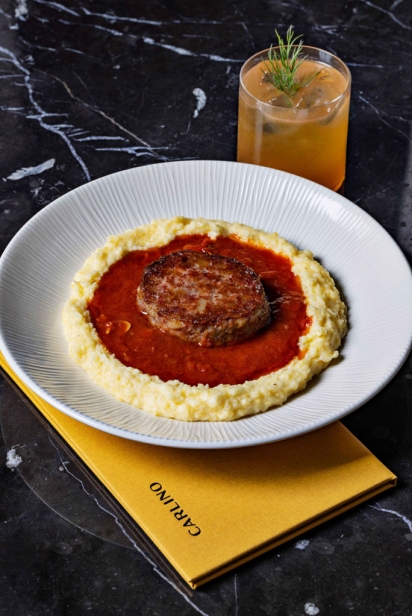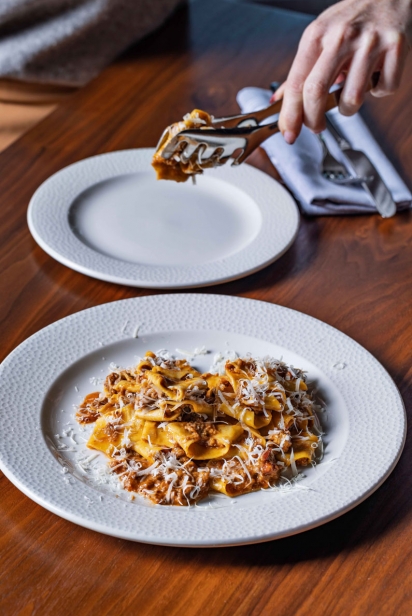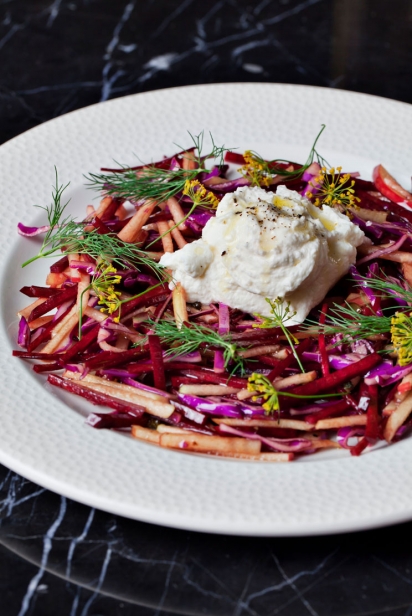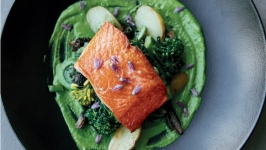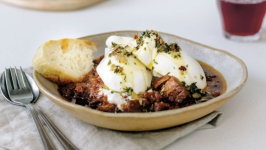Doing It His Way
When you visit Carlino, the new Italian restaurant in the Shangri-La Hotel, you might expect to find your favourite meatballs, pizza and burrata. But chef Mark Perrier is not going to give them to you.
“I tend to cook what I want. I don’t necessarily worry about what people want,” he says, adding firmly, “If people trust you, they are going to get a better meal.”
If you’re going to trust one chef in Vancouver, especially with Italian food, Perrier is your guy. He’s cooked red-gravy spaghetti and truffle-lavished Tuscan fine dining, he’s been a butcher and a hunter, and he’s opened not one but two establishments that landed on enRoute magazine’s top 10 list of the country’s best new restaurants.
Now he’s the chef at Carlino, the latest from Kitchen Table Restaurants. But this time, he’s not cooking the same old tomato-drenched favourites. He’s cooking the dishes of Italy’s northeastern corner, which owes as much, culinarily, to the Austro-Hungarian empire as it does the Roman one.
“I like the idea that it’s under-represented in Vancouver,” he says. “Here, it tends to be follow the leader. Every menu has agnolotti, every menu has cacio e pepe, every menu has carbonara. It’s boring.”
‘Too far gone’
Although Perrier has spent most of his career cooking Italian fare, he is not Italian. “I didn’t grow up eating Italian,” he says. “I grew up eating burgers.”
He began his career in fine dining, at West, CinCin Ristorante (where he rose to the position of executive chef) and a year-long stint at the two-Michelin-starred Le Gavroche in London. In 2009, he was Neil Taylor’s sous chef when they opened Cibo Trattoria, which was named Canada’s Best New Restaurant by enRoute magazine. He followed that by spending two years working as a whole-animal butcher for Two Rivers Specialty Meats. Then in 2015, he opened Osteria Savio Volpe as chef and partner. Savio went on to earn a top 10 spot on enRoute’s list, and Perrier went on to open the old-school Pepino’s Spaghetti House and the cosy wine bar, Caffe La Tana, as well.
But despite his key role in some of Vancouver’s most popular eateries, in early 2020 he seemed to disappear. He’s not the only one, of course. Since COVID shuttered restaurants in March 2020, countless cooks have hung up their aprons and quietly left the business.
“They’ve stopped cooking. And they are not coming back,” Perrier says, noting that the COVID pause gave everyone from line cooks to executive chefs a chance to find other, less terrible, ways to earn a living. “It isn’t a good job. It doesn’t pay the bills and Vancouver is an expensive city. And the hours never change. For the 20 years I’ve cooked, I’ve had no hobbies. You’re just a cook. That’s all you do.”
But Perrier’s journey was a little different than most. “I’m a chef. I have ‘line cook’ tattooed on my arm. I’m too far gone,” he says with a laugh.
He’d been thinking since summer 2019 of selling his interest in Savio and in January 2020 signed the papers. It couldn’t have been better timing. He spent the next year and a half away from the kitchen, mostly doing a lot of hunting and fishing. “It’s kind of the next step if you want to have control of what your family is eating,” he says. “I’m an intense person, so if I get into something, I really get into it.”
He also dabbled in a burger pop-up called GTO Burger, serving some of the city’s best smashburgers at random venues that would be announced on Instagram (gto.burger). “That’s sort of my long-term interest,” he says. “Fine dining is challenging, and it’s getting more and more challenging. The juice isn’t worth the squeeze. I wanted to do a burger restaurant and that’s still in the works.”
But he wasn’t quite ready to open it yet, and by September 2021, he says, “I was getting antsy — you can only sit around so much.”
That’s when he had a chat with Kitchen Table’s culinary director Alex Tung. “I was curious as to how everyone else was pulling back and these guys opened three restaurants. I wanted to know why they were so optimistic,” Perrier says. “I guess when everyone else is running for the exits, if you’re brave, you can be successful.”
‘Just the best’
When the pandemic began, Kitchen Table comprised Pourhouse, Ask for Luigi, Ristorante Di Beppe and Pizzeria Farina, as well as its North Shore sibling Farina a Legna. During COVID, it took over Giovane in the Fairmont Pacific Rim and re-opened it as Giovane Bacaro, a Venetian-style wine bar. It also opened Caffe Super Veloce in the Shaw Tower, and Miantiao, a Chinese-Italian fine-dining fusion restaurant in the old Jean-Georges location at the Shangri-La.
In a city with a large Asian population and an abiding love of noodles, Miantiao seemed like a sure thing. Certainly some of its dishes — especially the tajarin, a buttery ribbon-like pasta rolled into a cylinder and dusted with smoked beef heart shavings — enjoyed some Instagram popularity. But just a few months after opening in June 2021, Miantiao closed, making way for Carlino to open on December 1.
After all, Vancouver diners love Italian food. While one beloved independent restaurant after another has closed — the most recent is Bishop’s, falling prey to astronomical rent hikes after 36 years in business — Italian joints are thriving and new ones are popping up like porcinis in Piedmont. Among them: Tutto in Yaletown and Aquafarina a few blocks north, Oca Pastificio on Commercial Drive, a new Robba da Matti location in Gastown, Fiorino in Chinatown and, following the resounding success of Kitchen Table’s Bacaro, Carlino.
“Italian food is just the best, isn’t it?” Perrier says. “The thing with Italian food is it’s very approachable. Everybody loves pasta. Noodles are very transferable.”
But don’t expect to find noodles at Carlino, because they are not true to the cuisine of Northeastern Italy. The restaurant is named for the grandfather of one of the Kitchen Table owners, Nick Rossi, and its menu is inspired by his cultural heritage. Rossi’s father hails from Friuli Venezia Giulia and his mother from the Veneto, two regions tucked between the Dolomites and the Adriatic Sea, right up against the Slovenian border. (Carlino also takes inspiration from the other regions northeast of the Po River: Trentino, Alto Adige and Lombardy.)
“Nick had this idea of doing a whole restaurant around this ‘fai tu’ thing, family dining and that’s the way I like to cook,” Perrier says. “I’m a big research chef, so I did a bunch of research on the region. It’s very different from what we think of as Italian.”
The Italian food Vancouverites are familiar with mostly comes from farther south down the boot. Those popular pizzas and hearty, tomato-based dishes were imported by immigrants from Naples and Calabria, while Tuscany provided its steaks, Bologna its ragus and Rome its carbonara and cacio e pepe pastas.
“That northeastern pocket is quite different,” Perrier says. For instance, its cuisine features spices such as cumin and caraway that date back to the Venetian spice trade of the Middle Ages.
“There’s butter, there’s cream, there’s not so much pasta, there’s more polenta. Geographically, it’s a lot more similar [to B.C.] than southern Italy. Also, there’s a whole tradition there of hunting and wild mushrooms. So all of that matches up quite well.”
But are diners ready for dishes called cjarsons, toc in braide and musetto e brovade?
Fai tu, accompli
The best way to experience Carlino — especially if you are new to Friulian cuisine — is to enjoy the “fai tu” menu. “Fai tu” translates as something like “you do,” and is a sort of Italian family-style omakase, where you put yourself in the hands of the chef and trust him to feed you something delicious.
While Perrier is all about serving his food his way, in reality guests let the server know about any aversions or allergies, and what sort of meal they are looking for — light or rich, mostly vegetables or with plenty of meat — and the cooks will create something sure to satisfy. Each “fai tu” dinner comprises several antipasti, a couple of “primi” dishes (pasta, risotto and/ or polenta), a main, sides and dessert, all for $85 per person, served up in an airy third-floor space, with ochre banquettes and black-and-white checkerboard floors.
“What I think of as Italian food, it has to be simple. So there is nowhere for ingredients to hide. It is what it is,” Perrier says. “I worry about how it tastes. I don’t fuss with the plating.”
If you are not doing the fai tu menu, start your evening with any of the aperitivo-style snacks that go with bar manager Gianluigi Bosco’s juicy cocktails — olives with wild fennel, salt roasted hazelnuts or “frico,” irresistible little bites of fried cheese.
Definitely order the ricotta, made fresh in-house every day from organic cow and goat milk, drizzled with wildflower honey and served with dense, nutty focaccia-like bread called piza trentina. The cheese is rich and creamy, yet fluffy as a cloud, and a refreshing alternative to the ubiquitous burrata. “I am not doing buffalo mozzarella. I am not doing burrata,” Perrier says. “I am so over it.”
Follow that with one of the pasta, risotto or polenta dishes. As one would expect from a chef known for his exacting execution and obsession with sourcing only the best products, these are all painstakingly made in-house from the finest ingredients.
Perrier really wants you to try the polenta, and offers a dish called “toc in braide,” heirloom polenta topped with wild mushrooms and “fonduta,” a gooey melted cheese. But if you insist on pasta, expect to find shapes and flavours you’ve
never encountered.
There’s the fusi, which looks like “a little diaper” and is served with house ragu, or the francobolli, a stuffed pasta that looks like a postage stamp, and the cjarsons, a half- moon-shaped pasta filled with potatoes or beets, then tossed in lemony butter and poppy seeds.
You could end there or go on to the mains, which are a little more traditional (osso buco, roasted game hen, breaded pork chop), although the roast goat from Rossi’s family farm in Abbotsford is an unexpected inclusion. Plus, there is a nice selection of sides and sweets on which to graze, and an excellent regional wine list to enjoy alongside.
“I’m trying to stick with these classic, simple flavour combinations,” Perrier says. “I’m trying to get the food to the guest with as little manipulation as possible.”
‘Lots of headwaters’
This is a menu that will surprise a lot of diners, but in a good way. With so many restaurants pulling back, simplifying and adjusting their menus to diner demands, there are not a lot of culinary risks being taken right now, especially in fine dining. It’s exciting to taste something fresh and new and different, especially in the hands of a consummate pro like Perrier.
Since returning to the kitchen, Perrier has been a little bit taken aback by the low morale among his colleagues, by the staffing shortages and the difficulty getting supplies. “A lot of the small producers I used to rely on are gone, too. Lots of headwaters, right?” he says.
Still, he’s determined to keep doing things the way he always has: painstakingly, from scratch and with the very best ingredients he can get his hands on. “I’ve been able to assemble a great team of cooks,” he says. “I’ve been very, very blessed staffing wise.”
And he’s feeling optimistic, happy to be making his kind of food, his way. “I’m thinking the spring and summer [are] going to be quite good,” he says. “I’m really trying to go for it, as much as possible.”
Carlino Restaurant and Lounge, Shangri-La Hotel
1115 Alberni St, Vancouver, B.C.
carlinorestaurant.com | 604.695.1115 | @carlinorestaurant


